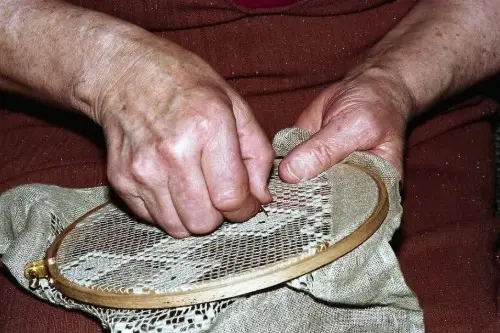1. Washing Clothes by Hand

Before washing machines were common, doing laundry by hand was a labor-intensive but ritualistic chore. Families would gather around a tub or washboard, often turning the work into a social activity. Today, washing machines and laundry services make the process nearly invisible, leaving few reasons to linger over the chore. The tactile experience of scrubbing and rinsing clothes is almost entirely forgotten by younger generations.
It wasn’t just about cleanliness—it was about rhythm, patience, and even pride in a job well done. People often had routines tied to weather, water collection, and drying clothes outside. Convenience machines removed that learning curve, making laundry faster but less communal. In losing the chore, we lost a quiet, shared time that connected people to their daily lives.
2. Sunday Family Dinners

Sunday dinners used to be a sacred weekly ritual, where the whole family gathered around the table for hours of food and conversation. Recipes were often passed down through generations, and everyone had a role, whether it was peeling potatoes or setting the table. Today, busy schedules and takeout apps make it easier to eat separately or order in, and the art of gathering feels lost. The slow simmer of family stories and home-cooked meals has been replaced by the beep of delivery notifications.
It wasn’t just about food; it was about presence. Kids learned life lessons, like patience and gratitude, in the kitchen and at the table. Now, screens often replace dialogue, and parents sometimes skip meals with kids to catch up on work or errands. The decline of Sunday family dinners reflects how convenience has edged out intentional bonding.
3. Canning and Preserving

Home canning was once essential, letting families store summer fruits and vegetables for winter. It was a skill, a science, and often a point of pride for homemakers. Today, supermarkets offer year-round produce, and mason jars mostly serve as décor. The hands-on process of boiling, sealing, and labeling has mostly disappeared, along with the anticipation of opening a jar months later.
Canning was also about self-sufficiency and creativity, experimenting with jams, pickles, and sauces. Children often learned how to identify ripe fruit and follow precise instructions from parents or grandparents. With the rise of convenience foods, people no longer need to invest hours into preservation. That tradition vanished because the value of time is often measured in speed rather than experience.
4. Letter Writing

Letters used to be the primary way to communicate with distant friends or relatives, and people poured thought, emotion, and sometimes art into each page. Handwriting mattered, paper selection mattered, and mailing a letter carried anticipation and ritual. Today, emails, texts, and social media replace all of that, delivering instant communication but losing the intimacy. Convenience has killed the patient, reflective practice of writing by hand.
Letters also left tangible memories—bundles of correspondence could be stored and revisited for years. They often documented family history and personal growth. Digital messages rarely carry the same permanence or emotional weight. What replaced it is fast, efficient, but emotionally shallow by comparison.
5. Home Sewing

Sewing used to be a household necessity: patching clothes, making linens, and even creating wardrobes. It taught patience, dexterity, and creativity. Today, mass-produced clothing and online shopping have made hand-sewn garments a rarity. Sewing machines still exist, but few use them for everyday needs anymore.
The decline of sewing is about more than convenience; it’s about losing a hands-on connection to clothing. Children no longer learn how to fix or make things, and skills once passed down quietly in the home have disappeared. Buying ready-made items is faster, cheaper, and requires no skill. But with that convenience, generations lost the quiet satisfaction of crafting something with their own hands.
6. Homemade Ice Cream

Homemade ice cream was a summer tradition in many households, requiring ice, salt, effort, and patience. Families would gather to take turns turning the crank while sharing stories. Today, store-bought pints and soft-serve machines make the craft mostly obsolete. The process and anticipation of enjoying your own creation have been replaced by instant gratification.
Making ice cream at home also fostered creativity with flavors, mix-ins, and family recipes. Kids learned the science of freezing and the satisfaction of teamwork. Convenience won, but it also took the fun, messy, and educational ritual with it. The sweet memory of sticky hands and shared laughter is now rare.
7. Ice Delivery

Before home freezers were common, iceboxes required regular deliveries from neighborhood ice men. Families had to plan meals around limited ice, and tipping the delivery man was part of the social etiquette. Today, refrigeration and freezer technology make daily deliveries unnecessary, completely erasing the ice man from memory. Convenience removed both the chore and the charm of anticipating a weekly delivery.
Ice delivery also influenced social interactions and community awareness—neighbors shared tips, exchanged small favors, and learned patience in a literal “chill.” The ritual may seem trivial now, but it represented a rhythm to daily life. Losing it is a tiny symbol of how technology quietly reshapes social habits. Modern homes are cooler, but emptier of small, human connections.
8. Sunday Paper Reading

Families once gathered around the Sunday newspaper for hours, absorbing news, comics, and local events. It was a tactile experience: flipping pages, clipping coupons, and debating headlines. Today, news is delivered digitally in real time, often fragmented and scattered. The ritual of slow, thoughtful reading has been replaced by scrolling and skimming.
Reading the paper together also encouraged conversation and critical thinking. Kids and adults alike learned to interpret events and develop opinions. That shared media experience is largely gone, replaced by personalized feeds. Convenience may inform us faster, but it doesn’t connect us in the same way.
9. Homegrown Vegetables

Growing a garden was once standard: tomatoes, beans, and herbs lined fences and backyards. It taught patience, responsibility, and respect for nature. Today, supermarkets stock produce year-round, and many people skip gardening entirely. The skill, pride, and flavor of harvesting your own food is lost to convenience.
Gardening also provided unstructured family time and taught lessons about seasons, pests, and nutrition. Kids could witness the full cycle from seed to plate. Convenience removed these small but formative educational experiences. The tradition faded because it takes effort and time that modern life often refuses to offer.
10. Board Game Nights

Before streaming and video games, families often gathered for board games on a regular schedule. Monopoly, Scrabble, and card games created shared memories and light-hearted competition. Today, screens dominate entertainment, and the collective focus of a table is less common. Convenience replaced engagement with passive consumption.
Board games also encouraged strategy, teamwork, and patience. Children learned to handle wins and losses gracefully. Digital games can mimic some of that, but rarely with the same physical and social intimacy. The tradition died because it required planning, presence, and attention—all things modern life squeezes out.
11. Home Remedies

Grandparents often relied on home remedies for common ailments: honey for coughs, teas for upset stomachs, and poultices for minor wounds. It was knowledge passed down through generations. Today, pharmaceuticals and online searches offer instant answers and products. Convenience removed both the experimentation and trust in ancestral wisdom.
These remedies also fostered creativity, problem-solving, and connection to the natural world. Children learned to observe effects, follow instructions, and value patience. Modern medicine is faster, but the personal involvement and sense of control over one’s health have diminished. Convenience won, but with it went a subtle form of empowerment.
12. Family Photo Albums

Before smartphones, photos were printed and carefully curated into albums, with handwritten captions and notes. Creating an album took effort, intention, and a sense of storytelling. Today, digital cameras and social media automatically store images, making physical albums rare. Convenience eliminated the tactile joy and reflection involved in choosing, printing, and preserving memories.
Albums also encouraged shared storytelling, as families revisited old trips, holidays, and milestones. Children could ask questions and hear anecdotes they might never see online. Instant access to digital images lacks the intimacy and narrative structure of a physical album. The tradition faded because speed often beats depth in modern memory-keeping.
13. Homebirths

Once common, homebirths were a central part of family life, with midwives guiding the process and neighbors supporting. They offered personal control and a deeply communal experience. Today, hospital births dominate in many countries, with medical convenience and safety protocols taking precedence. The ritual, learning, and empowerment associated with homebirths largely disappeared.
Homebirths also created a continuity of care and direct generational knowledge transfer. Mothers and families were intimately involved in every step. Modern convenience replaced these personal networks with standardized procedures. While safer in many ways, we lost a profound, hands-on approach to bringing life into the world.
This post 13 Home Traditions That Died When Convenience Won the Argument was first published on Greenhouse Black.
